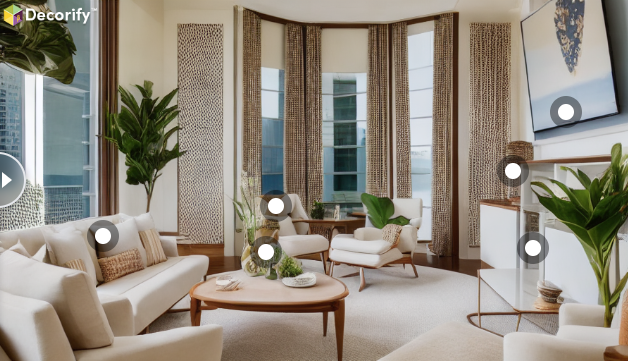That was fast. Just this spring, as the radical leaps forward in generative artificial intelligence were starting to make headlines, Business of Home predicted that home retailers would be looking to get in on the gold rush. Four months later, Wayfair rolled out its first AI-powered interior design tool. Others—from giants like Ashley to specialty sites like Desenio—are announcing new initiatives seemingly every day.
Retailers have every economic incentive to experiment with artificial intelligence, ranging from the cynical (for publicly traded companies, telling investors you have an AI strategy is a good idea) to the ruthlessly capitalistic (if an algorithm can replace an employee, margins go up). But to be fair to retailers, AI does offer intriguing possibilities for the future of shopping.
Consider, for example, back-to-school. Instead of scouring a rogue’s gallery of websites for the right thickness of pencil and a sweater that matches the Pantone color of your kids’ school uniform, imagine typing a few words into a search field and having perfect click-to-buy options for everything laid out in front of you. Or, for that matter, typing “I want to freshen up my living room” and seeing vibey pillows and a new cocktail table seamlessly inserted into a photo of your own home.
That potential helps explain why Amazon just invested a staggering $4 billion in AI startup Anthropic, and why even a historically tech-cautious player like Walmart is planning to roll out an AI-powered shopping assistant that—of course—includes an interior design component. The hype is there. The results, at least so far, are mixed.
GOING SHOPPABLE
Given its pedigree as a tech-forward company, it’s no shock that Wayfair was the first major home retailer to debut an AI-powered designer. The tool, dubbed Decorify, was launched in July. Though Wayfair says it has already produced more than 70,000 designs, the Boston-based company is careful to describe Decorify as a pilot program.
Anyone who has dabbled with one of the seemingly identical AI interior design tools that have popped up like post-rain mushrooms in the last year will be familiar with what Decorify can do. Users are prompted to upload a photo of a room and asked to choose a design style (“industrial,” for example). The algorithm then generates a new image, reimagining the room (in this case, with exposed brick and unfinished wood). Decorify’s “twist” is that the image is populated with little dots—all shoppable links to Wayfair product.
Decorify demonstrates both the strengths and the limitations of AI. The inspirational images it generates are relatively faithful to the original envelope of the room—though, expect plenty of the weird glitches that have become a familiar AI hallmark: windows swapped out for picture frames, for example. In terms of aesthetic quality, they are good, not great. Decorify-created rooms are both totally decent and absolutely not going to end up in a shelter magazine anytime soon.
The bigger problem is that the main hook of the tool—to connect users with actual product—is buggy. The program does not fill its images with literal Wayfair items. Like all generative AI, it’s drawing on vast databases of imagery and bringing users something like a mathematical average of a living room set. Decorify then scans the resulting image and looks for similar product in its own catalog.
A lot gets lost in that process. I tried creating several rooms with Decorify and “shopping” them, item by item. Occasionally, the tool would give me a fairly accurate match—a leather sectional in one image produced some pretty good look-alikes—but more often than not, the suggested products bore only a vague resemblance to the inspiration. Sometimes the results were way off: I clicked on some abstract wall art and Decorify suggested I was looking for a Christmas tree.
Walmart has teased a tool with similar functionality. It has yet to make its public debut, but since retailers are largely working with the same underlying technology, it’s difficult to imagine it will be leaps and bounds ahead.
It’s strange, in some ways, that a publicly listed company as big as Wayfair would roll out a technology with as many obvious bugs as Decorify, even as a pilot. But the seeming breakneck pace of AI advancement has pushed even the most cautious companies to ship imperfect product—Microsoft famously allowed The New York Times’s tech columnist to try out a chatbot that tried to break up his marriage. There may be a reason to rush out beta versions as well: The more feedback they get, the better. It’s possible that in three months, Decorify will wow.

AI PRODUCT
Some companies are taking the technology one step farther and using generative AI not just to recommend product but to create it. Earlier this year, U.K. fabric seller The Millshop Online rolled out an artificial intelligence-powered fabric design tool, Fabric Genie, and just a few weeks ago, Swedish retailer Desenio unveiled a tool called Imaginator, which creates artwork that can be turned into framed prints. Others will likely follow in the weeks and months ahead.
From a technology standpoint, FabricGenie and Imaginator represent something a little less ambitious than Decorify, though both are far less buggy. Instead of looking to blend generative AI with an existing photo, the entire process is contained within an algorithm. Users simply provide some text-based inspiration (“a floral pattern with bees and berries,” for example, or “a calming landscape in greens and blues”) and get a digital image back—ordering the physical product just takes a few extra clicks.
Like a lot of AI tools, both are immediately impressive, but the magic can wear off quickly. It’s fun to tinker with FabricGenie and run the algorithm through its paces, but it suffers from a kind of reverse Goldilocks problem. If you’re looking for a hyperspecific novelty pattern—retro astronauts dancing with punk rock bears, for example—the tool delivers. But how useful is that, really? And for more conventional patterns, the results are typically generic and uninspiring—slightly lesser versions of human-designed fabric that exist elsewhere on the market. Do you really need AI to generate a blue herringbone? The band of useful applications for FabricGenie seems narrow, at least in its current incarnation.
I felt similarly about Desenio. To be able to quickly spin up printable art is fun, but I never generated anything that felt like it truly belonged on a wall. The site includes links to “real” art displayed in the bottom margin of the Imaginator tool—and I found my eyes constantly drawn down to the human stuff.

DOES EVERYTHING NEED TO BE AI?
Thus far, a lot of the home retail experiments call to mind the classic “man with a hammer” parable. Right now, the technology is red hot, and brands of all stripes are looking to apply it to every single facet of their business. Some will likely pan out over time. But not every element of furniture shopping benefits from the addition of AI; not everything is a nail.
In a recent appearance at Salesforce’s annual Dreamforce conference, Williams-Sonoma CEO Laura Alber offered a curious-but-cautious take on how AI will matter to her business. “What does trust mean, and what breaks trust? When you think about things and people that you trust, they are reliable, they are helpful and they do no harm,” she said. “So when you think about brands that are going to win with AI, they have to really add value to the customers. They have to serve them better than they did before.”
Alber seemed much more excited about AI’s ability to impact operations: supply chain analysis, return logistics and the like. It’s possible that the flashy generative AI making headlines right now will burn off as marketing hype, and the real benefit to companies and consumers will mostly be behind the scenes. This year, Dufresne Spencer Group, a retail conglomerate that runs over 120 Ashley HomeStore locations, rolled out an AI-powered chatbot named Jenny—her purpose wasn’t to give design advice, but to reduce the number of missed deliveries.
“I wonder about a name change to ‘AI,’” said Alber. “I wonder if it’s just to be called ‘intelligence’ or ‘data intelligence.’ I think we should stop thinking about the definition as ‘artificial’ when it comes to the customer. The truth is that when it comes to customers, there can be nothing artificial about the experience.”




























